Lords of Midnight. Lords of Midnight. Lords of Midnight, Lords of Midnight. Lords. Of. Midnight. Lords of. Midnight. Lords of Midnight. Lords of Midnight. Lords; of Midnight. Lords, of, Midnight. Lords of Midnight -Lords of Midnight. Lords of Midnight.
Lords of Midnight.
Lords of Midnight.
Lords of Midnight.
Lords of Midnight.
Lords of Midnight. Lords of Midnight Lords of Midnight. Lords of Midnight.
Doomdark's Revenge.
Beyond Software is often eclipsed in the shadow of its most famous game, a bit like Software Projects. However at the time Beyond did build a reputation for innovative and serious games whereas most Software Projects games were released to the unspoken question "very nice but when's the next Manic Miner due?"
Terry Pratt, founding editor of COMPUTER & VIDEOGAMES, was moving sideways. He stepped away from his magazine after 27 issues because C&VG's publisher, East Midland Allied Press, was setting up its own software house; modestly called Beyond Software. There was obviously something in the air because Mirror Group Newspapers and Argus Press were all doing the same thing; with Mirrorsoft and Argus Press Software, obviously. Beyond Software always gave their address as Competition House, in Market Harborough, but Terry Pratt didn't have to move. Beyond's real address was Durrant House, 8 Herbal Hill, London EC1; given away in the March 1984 issue of GAMES COMPUTING (page 7). You won't be surprised to learn this was also the editorial address of C&VG.
Obviously it was convenient for EMAP to run the customer service side of Beyond through Market Harborough. They were a big newspaper and magazine conglomerate and would already have the setup to deal with mail order and special offers and so on. It's less convenient from my perspective because I'm scrabbling around trying to work out where Beyond were actually based, and when, and whether those offices were also part of the EMAP estate; the company had a lot of offices in the Farringdon area of London. But we'll get to that later. Competition House is gone. I checked out Farndon Road virtually on Streetview, without success. The former site could be under the big newish housing estate on the outskirts of town or, more likely, as you travel into Market Harborough there's a big, older looking, industrial estate which includes Cable House, Barking House, and Barberton House. I reckon Competition House was somewhere around there. Out of curiosity I emailed the Harborough Museum and got a very nice reply which unfortunately just confirmed what I already knew. Competition House doesn't exist any more and its location is not known. So let's move to London.
Durrant House, 8 Herbal Hill, London EC1.
POPULAR COMPUTING WEEKLY interviewed Terry Pratt in mid-1984 (5-11 July page 12). The interview starts with a cynical tone:
Until recently Beyond were yet another software house that seemed destined for a pretty quick oblivion - it was spending a lot of money on adverts for games that were, at best, average and at worst terrible. We journalists (all knowing beings from the plane of darkness) sniggered to ourselves and put them on the vast list of 'companies most likely to' (go broke).
The interview then settles down and goes on to give some backstory to the founding of Beyond.
Terry is a classic example of putting your money where your mouth is, (actually someone else's money but his credibility). Prior to Beyond he was the editor of the still flourishing Computer and Video Games magazine, "I suggested vaguely to the powers that be the idea of doing some software after seeing the quality of some of the stuff we were getting in on the magazine but I never expected to be looking after a separate company... I will admit that one thing that spurred me on was, when I was on the magazine, the hash I had seen other people make of running a software house — I thought I could do it better. We're succeeding now but It certainly was much more difficult than I thought."
Terry skirts quickly over Beyond's poorly received early releases: "The first games were always a preliminary stage just to test the water. Beyond only really took on any staff in April." By July 1984 the company had two well-regarded titles under its belt; Psytron and (you guessed it) Lords of Midnight. C&VG's Bug Hunter column had some fun with Psytron in December 1984, there was a demo for the game on side two of Lords of Midnight and a reader found a love poem hidden in the demo's machine code:
Dear Fiona,
You are too precious for mere words but maybe "I Love You" will do. Sometimes, late at night, I hear you cry, while I lie awake and wonder why someone so good and so true could get so upset, down and blue. I know I'm hard at times when perhaps you need me most, but we all have our destiny and that's no idle boast Wherever I am, whatever I do, always remember I love you.
 |
| C&VG June 1984 page 155 |
Design Design took against Psytron, for the marketing rather than the poetry:
But clearly the game that has most annoyed them recently is Psytron. 'It really got up our wick,' Graham [Stafford] says indignantly. 'Not because it is selling well but because they get up and say that that program makes other programmers gasp! And it doesn't.'
(CRASH, September 1984 page 90)
The PCW interview with Terry Pratt notes that: "Good as Psytron is, my guess is that Lords of Midnight is the game people will still be talking about in ten years time." Make that 40, and still counting. Mike Singleton died in 2012 and most people that know him, know of him because of Lords of Midnight. The raw numbers of the game are impressive, 4000 locations, 32,000 different views, 32 main characters, all in 48K, but the real triumph is the imaginative leap it took to create the world, the land of Midnight, and its hazards and its characters. Luxor the Moonprince and his son Morkin have different skills and abilities. Doomdark is a proper foe with multiple objectives. Night falls and you have to camp while the forces of the Witchking are abroad. You can spot a tower in the distance and walk there -old hat now, but this was 1984. What I find fascinating is that this imaginative world started from a purely technical challenge, as Mike Singleton told CRASH:
 |
| C&VG March 1984 page 16 |
‘Landscaping’ is Mike’s own technique, and is the one on which his Midnight Trilogy is based. When I was considering the game I felt the graphics had to be more relevant to the action. So often the graphics in other adventures appeared purely decorative.’
Using Landscaping, a player can actually see his journey in real time, with, in the case of Lords Of Midnight, 32,000 views. From the technique, perhaps, came the theme. Mike wanted to create a massive playing world, so objects like spy satellites were out, because so many view points would be taken away from the landscape below. And so the murky Middle Ages were chosen as the setting, with all the scenes set firmly at eye-level and the landscape features seen from the player’s viewpoint.
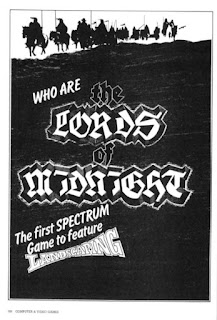 |
| C&VG April 1984 page 166 |
‘The Land of Icemark,’ explains Mike, ‘simply came about from the graphic capabilities of the Spectrum. I happened to like the combination of white on blue and so it fitted in rather well.’ (June 1987 page 45)
"I think the code is very neat," Mike Singleton told SINCLAIR USER (Annual 1985 page 41) in a great understatement of the 20th century. "The major problem was the memory. With one or two K extra it could have been finished earlier. Believe it or not, it was streamlined three times. I squeezed the extra out of it by compression."
Doomdark's Revenge, Mike Singleton's sequel to Lords of Midnight, arrived before the end of 1984. Doomdark's Revenge somehow doesn't have the legacy of Lords of Midnight despite being a bigger and more impressive programming achievement. It only ever seems to be talked about in the context of Lords of Midnight rather than as a game in its own right, as I'm doing here. Maybe the problem is that having served up one programming miracle in 1984 doing it again just resulted in people shrugging and going "that's great, can you do it again?" There was supposed to a third game Eye of the Moon but Mike Singleton moved on to other projects. Eye of the Moon was much talked about in interviews, and always appeared to be on the cusp of release, but only tantalising hints ever appeared:
The game would have 16,000 locations "I can't tell you how it will be done," says Singleton. "It you want a clue, it will all fit into 256 bytes," YOUR COMPUTER April 1986 page 63.
"The Landscaping should be in full colour," CRASH June 1987 page 45).
"Beyond hope to have the memory to include a facility, by which two players can play the game simultaneously on two Spectrums," COMPUTER GAMER, July 1985 page 5
"It involves a much larger area, 12 different countries, and much more individualisation of landscape — every tree will look different," YOUR COMPUTER October 1985 page 45
"Morkin goes off in search of the magical jewel called the Eye of the Moon which enables people to see into the future, so that Luxor can then rest in peace... [I was] wondering whether we should have an enemy that you have to defeat or just an enemy who's possibly hindering you, but not be the main objective. It's also debatable what Luxor finds when he looks into the jewel. Someone suggested he finds that Midnight has been turned into a multistory carpark!" CRASH March 1985 page 98.
Obviously I could talk about Lords of Midnight all day so lets drag things back on track by noting that CRASH's March 1985 interview features a picture of Mike Singleton helpfully captioned as "outside Lime Street Station in Liverpool."
 |
| CRASH March 1985 page 87 |
This proved harder to track down than you'd think, even knowing where it was taken and being able to see the Radio City Tower in the background. The reason for my confusion, that big tower block in the background, Concourse Tower, has gone. "Liverpool's ugliest building," was demolished in 2009.
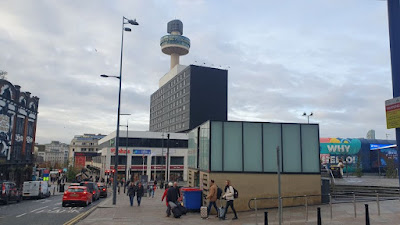 |
| December 2022 |
 |
| October 2023 |
Terry Pratt might remember things differently. He described the C&VG offices as, "a dingy office, three floors above a bombsite in London's EC1." Those offices are still there, less dingy in the early afternoon sun, and more gentrified than in the C&VG/Beyond days. The Guardian used to lease offices next door, 3-7 Herbal Hill, until around 2008. In fact Farringdon was for a long time Guardian ground zero. Their main offices were once round the corner at 119 Farringdon Road and I walked passed the old building a couple of times.
Telecomsoft was rich with cash from sales of Elite. According to PCW they paid "a six figure sum" to EMAP. The First Star deal seems to have been one of the things that caught BT's eye: "We were keen on the First Star link," Ederyn Willams [general manager of New Information Services, BT's electronic publishing arm] told PCW: "we feel that the software market will have a transatlantic character. Indeed Firebird has two people out in the US now launching Elite there. We're delighted to have made this deal -Beyond has a number of valuable assets and unreleased products." Bill Delany joked: "Here at Beyond it will be business as usual - it's simply that the bank has changed. We're probably with a bigger bank now, " The Bird Site is (or rather was, it's only on the Internet Archive now) a site by Richard Hewison who worked for Telecomsoft. It included a page for Beyond which notes darkly that: "Some of the management within British Telecom felt that they paid over the odds for the company." RETRO GAMER (issue 221) would later put the over the odds figure at £1,000,000
Note the caption. "Beyond- reckons it can get Star Trek out by October." They couldn't. SINCLAIR USER ran a news item in December 1986 headlined Beyond A Joke and revealed the game had been delayed into 1987, along with another game being worked on by Mike Singleton called Dark Sceptre:
Beyond took two games from the Liverpool team of Denton Designs. Steve Cain, one of Denton's founding six, recalled to SINCLAIR USER: "We talked to Bill Delaney at Beyond Software for half an hour and after that we were Beyond 's men." [record scratch sound effect]. We'll come back to Denton Designs in a moment but first, who's Bill Delaney? Well, he's managing director of Beyond by the time Steve Cain contacts the company in late 1984. What's happened to Terry Pratt? I don't know and his LinkedIn profile doesn't give any clues. It's not stalking. It's research. Terry Pratt's listed as publisher on SINCLAIR USER from issue 50, May 1986, so it looks like he dived back into the magazine side of the business with EMAP. And now back to Denton Designs.
Steve Cain told SINCLAIR USER: "[Beyond] had Lords of Midnight. Sometimes you see things by other people and you say 'I wish I'd done that'. Well, we thought we could produce things like that without having people of the calibre of Bruce Everiss around to cock it up for us... Beyond agreed to take two games from us, fund our development and premises. They wanted us badly but weren't prepared to take an almighty risk." Those two games were 1985's innovative icon-driven Shadowfire and a sequel called Enigma Force.
Beyond launched a spinoff label called Monolith at the end of June 1985. SINCLAIR PROGRAMS ran a report in their May 1985 issue and suggested the new label would be for arcade games while the Beyond name would still be used for adventure and strategy titles. Mike Singleton, with Warren Foulkes, was working on a Commodore 64 game Quake Minus One. Denton Designs were creating a future sport game provisionally called Iron Heroes or Bouncers. Monolith launched with a compilation called Boulder Dash II: Rockford's Riot that bundled First Star's Boulder Dash II: Rockford's Revenge with original game Boulder Dash. Beyond had snaffled the UK rights to First Star games away from State Soft, and game star Rockford moved to another new company.
2 St John's Place, St. John's Square, London, EC1M
Then there's this address. It only appears once, so far as I can tell, in this small-ish job advert. I have questions. Possibly more questions than a simple quarter page advert should provoke. Let's keep it simple. Is St John's place yet another EMAP office of which I should be aware? Oh and one other bonus question is that Simon Goodwin the same who later went on to write technical articles for CRASH?
St Johns Square is one of those parts of London which comes as a surprise. A paved square which opens right off Clerkenwell Road. The first thing you see as you walk in is a sturdy stone gate which incongruously links two more modern buildings. This St John's Gate, the south entrance to what was once the inner precinct of Clerkenwell Priory. Unfortunately the second thing you see is a vile sixties office block at 1 St John's Place called Gate House which lurks hideously at the entrance to the square. It's such an awful contrast to the surrounding buildings that it must be the punchline to a long-lost joke between architects.
Fortunately I wasn't looking for Gate House. St John's place runs down the side of Gate House and 2 St John's Place is tucked away down the end. The road is so narrow that I couldn't get a decent photo until I'd backed all the way up to the square. Number two is the red brick and concrete building on the left, past the side of the cream coloured bar.
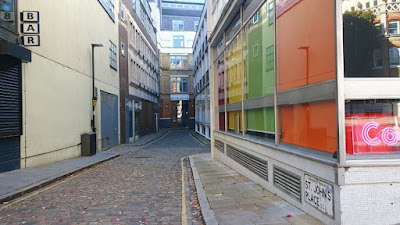 |
| October 2023 |
3rd Floor, Lector Court, 151 Farringdon Road, London, EC1R
When SINCLAIR PROGRAMS reported on the launch of Monolith they gave a new address for Beyond; and SINCLAIR PROGRAMS should know, they were also published by EMAP. Beyond adverts still carried the Market Harborough address to the end of the Spy Vs Spy campaign in July and then the new Farringdon Road address crops up on adverts for the Monolith range, starting in August 1985. Beyond was brought by Telecomsoft in October 1985. Did EMAP move Beyond to new offices to distance it from the parent company prior to a sale, which is what BT did to Telecomsoft the following year when they started making sale plans. Was that what was going on here or was 151 Farringdon Road yet another outpost in the EMAP expanse? I don't know.
 |
| October 2023 |
Well, these photos can't all be gems. Consider this one part of a time capsule of London in all its faces and moods of development. No? Please yourself. Lector Court is, I think about halfway down this scaffolding wall. Drop back to the 2022 Streetview picture and its easy to find Lector Court because the owners have thoughtfully attached discrete signs to the frontage identifying each of the four different buildings; Scriptor Court, Lector Court, Clover House, and River House. In the photo above, you can just see the old Guardian offices on the left.
 |
| POPULAR COMPUTING WEEKLY 17-23 October 1985 |
Wellington House, Upper St. Martin's Lane, London, WC2H
Beyond's life as a Telecomsoft label is not a good one. The company slowly winds down to a series of poor decisions and bad luck. Bill Delany, despite his banter to PCW, wasn't happy. RETRO GAMER (issue 221) reported that the September 1985 news came to him "like a bolt from the blue". He didn't want to work for Telecomsoft and by January 1986 he was gone. Programmers Paul Voysey and Tayo Olowu, writers of Psytron and Psi-Warrior, had been independently developing a game for Beyond called NEXUS. They also didn't like the implications of the deal and the three joined forces, formed a company called -confusingly- Nexus, and released NEXUS six months later. COMMODORE USER managed to review NEXUS twice, once as a Beyond game in October 1985 and again, less enthusiastically, in July 1986.
The Monolith label disappears leaving Boulder Dash II: Rockford's Riot as its only title. Quake Minus One and Bounces, the renamed Iron Heroes/Bouncers, both credit Monolith on their title screen but are released in standard Beyond packaging; as if no one could be bothered, or remembered, to change the credit. Also intended for Monolith was a UK release of First Star's Superman: The Game, according to The Bird Site a major reason for Telecomsoft's acquisition of Beyond. Quite why Telecomsoft was so excited about Superman is anyone's guess. This is a good couple of years before the cool rebirth of comics as graphic novels. The film Superman III was two years old and Superman IV wouldn't start production until 1986. Ocean's first successful Batman game was around six months away. There was little reason to be excited about a good Superman game.
The C64 version of Superman was not a good game. It arrived to rotten reviews on the Beyond label around Christmas 1985. The Spectrum and Amstrad releases were delayed and delayed and seem to have finally come out a year later at the budget price of £2.99. First Star's name is prominent but there's no credit for Beyond or any of the familiar BT labels like Rainbird or Firebird. There's simply a British Telecom logo and the words "published in the UK by Telecomsoft." Around the same time Telecomsoft was treating games supplied by Odin in the same way, so it's possible this is just standard procedure although, to me, it's about as close as you'll get to seeing a game kicked out of the back door before anyone notices. The First Star deal ends with Superman. Around October 1985, on the C64, Beyond released Spy vs Spy The Island Caper, and normal procedure would be for an Amstrad and Spectrum conversion to follow. They don't. The conversions only see release in in 1987 by a different company, Databyte, who also publish the third game Spy vs Spy Artic Antics.
Beyond went very quiet in 1986. The Bird Site says: "Telecomsoft didn't do much with Beyond once the titles that had been in development were completed. Star Trek: The Rebel Universe was initiated to mark Beyond's ownership under BT."
Star Trek was popular in the UK because it had been repeated almost continuously on the BBC since it premiered in 1969. As a result the licence was big news and POPULAR COMPUTING WEEKLY reported the deal in July 1986:
BEYOND'S major project for this Autumn is to be the first official Star Trek computer game. Beyond has licensed the title from Paramount and is to launch the game in late September, the 20th anniversary of the TV program.
The programming team working on the project is headed by Mike Singleton. author of the Lords of Midnight series. It will be released initially in Spectrum, Commodore, Amstrad and Atari ST format.
The September release date was canny. Not only was it the 20th anniversary but the game would also benefit from news about Star Trek IV: The Voyage Home which was due for release in America in November 1986, although the UK wouldn't get to see film until April 1987. SINCLAIR USER's Gremlin column was less impressed by this news from their ex-EMAP colleagues:
Could it be true? Probably not. A well known software house is believed to have coughed up 50,000 green backs for the home computer botch up rights to Star Trek.
This will give the said software house the freedom to make an absolutely appalling job of converting the film, TV series, books, maps and everything else into a computer game — after everybody else.
Gremlin predicts the following : the game will feature indistinct icons of various members of the Enterprise crew, to whom you can issue orders which they might or might not act on (this will be called artificial intelligence) the battle scenes will be like Elite only more boring, it will be called an arcade adventure strategy game and the plot will involve saving a planet from the Klingons doing battle a lot and keeping the Dilitheum crystals topped up Scotty. There will be a huge instruction booklet, it will be a Christmas biggy and will get to number one.
(SINCLAIR USER July 1986 page 106)
The game wasn't ready for Christmas 1986. Despite Beyond promoting it at the 1986 PCW Show by dressing their stand as the USS Enterprise. Not many pictures seem to exist; this is the only one I've found from SINCLAIR USER (October 1986 page 10)
Beyond is however, adamant that the late releases - a significant blow for the company are not the result of programmers bickering over money, or rumours of problems within the Telecom's Software division's hierarchy, following the departure of label manager Francis Lee.
According to new Beyond spokesperson Tom Watson "The problem is we licensed the Star Trek title through Simon and Schuster in America, not directly from the TV company Paramount and so everything we has to be approved and that takes 21 days
...
...
Meanwhile, Mike Singleton, Star Trek team leader, has dropped work on his other project, Dark Sceptre, to concentrate on Mr Spock's ears.
Dark Sceptre and Star Trek were both delayed into 1987, in August, YOUR SINCLAR updated:
Apparently the bigwigs who own the rights to Star Trek and all its spin-offs have insisted that they okay every single aspect of the game. Frontlines hears that they recently rejected one Speccy version because Spock’s ears were two pixels too long!
The backwards and forwards of versions across the Atlantic for approval might explain an odd throwaway comment in C&VG. The magazine was celebrating its fifth birthday in November 1986 and Terry Pratt returned to write a short article about the problems putting together the first issue; which mainly revolved around creating and getting approval to publish a ZX81 Star Trek listing. Right at the end of Terry's reminiscence is the sentence: "we've got Beyond on the phone. Seems they never gave you permission to use the digitised pictures of the Star Trek crew on page 8 of the Oct..." If images were constantly being submitted to Paramount for approval and C&VG managed to print an unapproved one, then that could have generated a panicked call. The postage-stamp sized picture which caused such consternation in issue 60 looked like this:
March 1987 saw SINCLAIR USER report that Mike Singleton's two games were: "the only two products under development by [Beyond]. This either means the label is in trouble or it means they should be finished fairly pronto (take your pick) The ST version of Star Trek is currently being played tested in the States - by the licensees - and once that's released - [Stardate 24.9.Anybody's guess ) - the Spectrum version should follow shortly." By December 1987 the non-appearance of Star Trek had become a joke and earned the game a mention in ACE magazine's National Micro Disaster Awards 1987; December 1987 page 20.
Some say that despite the reputedly enormous amounts of money spent on the design and programming (£60,000 to one individual, the story goes) the early versions were naff. Others murmur about clauses in the licence contract giving Paramount the right to veto any part of the game. From the shape of Spock's ears to the picture on the packaging. Will we ever learn the truth? Who knows. Will we ever see the game? Yes, we certainly will - and real soon now, The ST version will be around before Christmas, a-bit versions in the new year. In fact, if you want to see it right now, just mosey on down to your friendly local pirate - ST versions have been available on the hackers network quite some time, making Star Trek the most widely seen unreleased game of all time.
Dark Sceptre made it out to review by the end of 1987. Star Trek: The Rebel Universe (to give the game its full title) followed soon after on the Atari ST, with the C64 version limping out around in time for Christmas 1988. ACE visited Maelstrom games in April 1988 and Mike Singleton had something to say about his reputation for late delivery:
Fans of Star Trek will know that prompt delivery isn't exactly Mike's style, but he's very quick to defend himself: 'Yes. I've certainly got something to say about that - most of the games where poor old Mike Singleton has been singled out for missing deadlines have not been games where poor old Mike Singleton has been doing the programming. That was the trouble with Star Trek, for example - half the programming team just beamed off in the middle of the protect. We just had to start off again with a fresh team.' The same thing happened, apparently, with Dark Sceptre.
Dark Sceptre and Star Trek both outlasted the label which commissioned them. Beyond had quietly disappeared some time in 1987. Telecomsoft finally released both games on their Firebird label.
If you know where Competition House was then leave a comment or email whereweretheynow@gmail.com. Join me and ride the social media carousel; I'm on Twitter, @shammountebank, wave-of-the-future (maybe) Bluesky @shammountebank.bsky.social, and Instagram https://www.instagram.com/shammountebank/





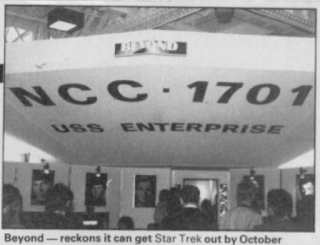
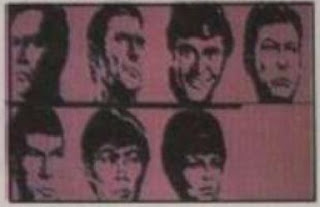






No comments:
Post a Comment